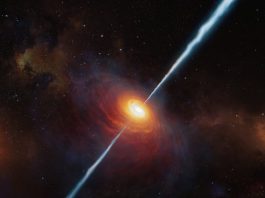La missione JUNO della NASA ha completato il fliby all’interno dell’atmosfera di Giove passando nei pressi della grande macchia rossa il 10 luglio durante la sua sesta orbita scientifica.
Tutti gli strumenti scientifici di Juno, compresa la JunoCam hanno funzionato regolarmente durante il fliby, raccogliendo dati che sono ora in corso di trasmissione sulla Terra. Il prossimo volo di Juno su Giove avrà luogo il 1 Settembre.
Le immagini originali dell’ultimo flyby della navicella saranno pubblicate nei prossimi giorni, intanto ecco le prime immagini elaborate rilasciate dal JPL. Nei prossimi giorni ne seguiranno altre ancora più interessanti:

The image was taken on July 10, 2017 at 07:07 p.m. PDT (10:07 p.m. EDT), as the Juno spacecraft performed its 7th close flyby of Jupiter. At the time the image was taken, the spacecraft was about 6,130 miles (9,866 kilometers) from the tops of the clouds of the planet.
“For hundreds of years scientists have been observing, wondering and theorizing about Jupiter’s Great Red Spot,” said Scott Bolton, Juno principal investigator from the Southwest Research Institute in San Antonio. “Now we have the best pictures ever of this iconic storm. It will take us some time to analyze all the data from not only JunoCam, but Juno’s eight science instruments, to shed some new light on the past, present and future of the Great Red Spot.”
As planned by the Juno team, citizen scientists took the raw images of the flyby from the JunoCam site and processed them, providing a higher level of detail than available in their raw form. The citizen-scientist images, as well as the raw images they used for image processing, can be found at: httpss://www.missionjuno.swri.edu/junocam/processing
Annuncio pubblicitario
Interessato all'Intelligenza Artificiale?
Prova a leggere su Amazon Unlimited la nostra guida su come installarne una in locale e come ricavarne il massimo.
Una Intelligenza Artificiale locale ti permette di usufruire di tutti i vantaggi derivanti dall'uso dell'IA ma senza dover pagare costosi abbonamenti.
📘 Leggi la guida su Amazon“I have been following the Juno mission since it launched,” said Jason Major, a JunoCam citizen scientist and a graphic designer from Warwick, Rhode Island. “It is always exciting to see these new raw images of Jupiter as they arrive. But it is even more thrilling to take the raw images and turn them into something that people can appreciate. That is what I live for.”

The image was taken on July 10, 2017 at 07:10 p.m. PDT (10:10 p.m. EDT), as the Juno spacecraft performed its 7th close flyby of Jupiter. At the time the image was taken, the spacecraft was about 8,648 miles (13,917 kilometers) from the tops of the clouds of the planet.
All of Juno’s science instruments and the spacecraft’s JunoCam were operating during the flyby, collecting data that are now being returned to Earth. Juno’s next close flyby of Jupiter will occur on Sept. 1.
Juno reached perijove (the point at which an orbit comes closest to Jupiter’s center) on July 10 at 6:55 p.m. PDT (9:55 p.m. EDT). At the time of perijove, Juno was about 2,200 miles (3,500 kilometers) above the planet’s cloud tops. Eleven minutes and 33 seconds later, Juno had covered another 24,713 miles (39,771 kilometers), and was passing directly above the coiling, crimson cloud tops of the Great Red Spot. The spacecraft passed about 5,600 miles (9,000 kilometers) above the clouds of this iconic feature.
Juno launched on Aug. 5, 2011, from Cape Canaveral, Florida. During its mission of exploration, Juno soars low over the planet’s cloud tops — as close as about 2,100 miles (3,400 kilometers). During these flybys, Juno is probing beneath the obscuring cloud cover of Jupiter and studying its auroras to learn more about the planet’s origins, structure, atmosphere and magnetosphere.
Early science results from NASA’s Juno mission portray the largest planet in our solar system as a turbulent world, with an intriguingly complex interior structure, energetic polar aurora, and huge polar cyclones.
“These highly-anticipated images of Jupiter’s Great Red Spot are the ‘perfect storm’ of art and science. With data from Voyager, Galileo, New Horizons, Hubble and now Juno, we have a better understanding of the composition and evolution of this iconic feature,” said Jim Green, NASA’s director of planetary science. “We are pleased to share the beauty and excitement of space science with everyone.”
JPL manages the Juno mission for the principal investigator, Scott Bolton, of Southwest Research Institute in San Antonio. The Juno mission is part of the New Frontiers Program managed by NASA’s Marshall Space Flight Center in Huntsville, Alabama, for the Science Mission Directorate. Lockheed Martin Space Systems, Denver, built the spacecraft. JPL is a division of Caltech in Pasadena.
More information on the Juno mission is available at: httpss://www.nasa.gov/juno

The image is approximately illumination adjusted and strongly enhanced to draw viewers’ eyes to the iconic storm and the turbulence around it.
The image was taken on July 10, 2017 at 07:07 p.m. PDT (10:07 p.m. EDT), as the Juno spacecraft performed its 7th close flyby of Jupiter. At the time the image was taken, the spacecraft was about 6,130 miles (9,866 kilometers) from the tops of the clouds of the planet.
“Per generazioni persone di tutto il mondo hanno espresso meraviglia per la grande macchia rossa di Giove”, ha dichiarato Scott Bolton, ricercatore principale di Juno “Ora finalmente potremo vedere da vicino questa tempesta”.
La macchia rossa è una tempesta di 10.000 miglia di larghezza (16.000 chilometri di larghezza) che è stata monitorata dal 1830 e che probabilmente è in corso da più di 350 anni. Negli ultimi anni , la grande macchia rossa sembra essere rimpicciolita.
Juno ha raggiunto il perijove (il punto in cui l’orbita si avvicina al centro di Giove) il 10 luglio alle 6:55 pm PDT (9:55 pm EDT). Al momento del perijove, Juno era circa 2.200 miglia (3.500 chilometri) sopra le nuvole del pianeta. Undici minuti e 33 secondi più tardi, Juno aveva coperto altri 24.713 miglia (39.771 chilometri) ed era passato direttamente sopra le nuvole cremisi velate del Grande Rosso. La nave spaziale passava circa 5.600 miglia (9.000 chilometri) sopra le nuvole di questa caratteristica iconica.
Il 4 luglio alle ore 19:30 PDT (10:30 pm EDT), Juno ha registrato esattamente un anno in orbita di Giove, segnando 71 milioni di miglia di viaggio intorno al pianeta gigante.
Juno è stata lanciata il 5 agosto 2011, da Cape Canaveral, Florida. Durante la sua missione di esplorazione, Juno si è avvicinata alle nubi del pianeta fino a circa 2.100 miglia (3.400 chilometri). Durante questi flybys, Juno ha sondato la cappa scura di nuvole tentando di scoprire cosa vi sia sotto e ha studiato le aurore di Giove per saperne di più sulle origini, sulla struttura, sull’atmosfera e sulla magnetosfera del pianeta.
I primi risultati scientifici della missione JUNO della NASA rappresentano il più grande pianeta del nostro sistema solare come un mondo turbolento, con una struttura interiore intrigante e complessa, una polarità polare energica e enormi cicloni polari.
Il JPL gestisce la missione Juno attraverso il ricercatore principale, Scott Bolton, dell’Istituto di ricerca sud-occidentale. La missione Juno fa parte del programma New Frontiers gestito dal NASA Marshall Space Flight Center di Huntsville, Alabama, per la Direzione Missionaria della Scienza. La sonda è stata costruita da Lockheed Martin Space Systems di Denver. Il JPL è una divisione del Caltech di Pasadena. Maggiori informazioni sulla missione Juno sono disponibili all’indirizzo:
Il pubblico può seguire la missione su Facebook e Twitter a:
httpss://www.facebook.com/NASAJuno
httpss://www.twitter.com/NASAJuno
DC Agle
Jet Propulsione Laboratorio, Pasadena, California
818-393-9011 / 818-354-6278
agle@jpl.nasa.gov






